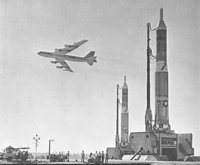Titan I
|
|
| Titan I | ||
|---|---|---|
| Missing image Titan_1_ICBM.jpg Launch of a Titan I ICBM from Cape Canaveral | ||
| Stages | 2 | |
| 1 - 1st Stage | Engines | LR87-AJ-3 |
| Thrust | 1,334 kN | |
| Burn time | 140 seconds | |
| Fuels | RP-1/LOX | |
| 2 - 2nd Stage | Engine | LR91-AJ-3 |
| Thrust | 356 kN | |
| Burn time | 155 seconds | |
| Fuels | RP-1/LOX | |
| ICBM | 1st Launch February 1959 | |
| Payload LEO | 3,000 lb (1,816 kg) | |
The Titan I was the United States' first true multistage ICBM. It was the first in a series of Titan rockets, but was unique among them in that it used LOX and RP-1 as its fuels, while the later versions all used storable fuels instead.

The program began in January 1955 and took shape in parallel with the Atlas (SM-65/HGM-25) intercontinental ballistic missile (ICBM). The Air Force's goal in launching the Titan program was twofold: one, to serve as a backup should Atlas fail; and two, to develop a large, two-stage missile with a longer range and bigger payload that also could serve as a booster for space flights.
The XB-68 designation had originally been applied to a stillborne jet bomber design by Martin which was cancelled before two prototypes and one test model were completed.
Produced by the Glenn L. Martin Company (which became "The Martin Company" in 1957), Titan I was a two-stage, liquid-fueled missile. The first stage delivered 300,000 pounds force (1,334 kN) of thrust, the second stage 80,000 pounds force (356 kN). The fact that Titan I, like Atlas, burned RP-1 and LOX was a severe drawback.
The missile utilized both radio and all-inertial guidance. Deployed in a "hard" underground silo, it had to be raised to surface by a special launcher for firing. The Titan I had an effective range of 5,500 nautical miles (10,200 km). As each stage was fired, its engines and fuel tanks dropped away, thereby decreasing the mass of the vehicle. That made for a more efficient missile, which resulted in increased range and enabled a larger payload.
When the storable fueled Titan II and the solid fueled Minuteman I were deployed in 1963, the Titan I and Atlas missiles became obsolete. They were retired from service as ICBMs in early 1965. The Titan II remained in service until the 1980s however, as it carried a much larger payload that could be used as an effective "city buster".
Titan 1 Specifications
- Liftoff thrust: 1,296 kN Total mass: 105,142 kg
- Core diameter: 3.1 m. Total length: 31.0 m
- Development Cost: $ 1,643,300,000.00 in 1960 Dollars.
- Flyaway cost: $ 1,500,000.00 each, in 1962 Dollars.
- Total development missiles built: 47. Total missiles fired: 68.
- Total production missiles built: 108. Total deployed missiles: 54.
- Titan 1 First Stage:
- Gross mass: 76,203 kg
- Empty mass: 4,000 kg
- Thrust (vac): 1,467 kN
- Isp (vac): 290 s (2.84 kNs/kg)
- Isp (sea level): 256 s (2.51 kNs/kg)
- Burn time: 138 s
- Diameter: 3.1 m
- Span: 3.1 m
- Length: 16.0 m
- Propellants: Liquid Oxygen (Lox) / Kerosene.
- Number of engines: Two - LR-87-3.
- Titan 1 Second Stage:
- Gross mass: 28,939 kg
- Empty mass: 1,725 kg
- Thrust (vac):356 kN
- Isp (vac): 308 s (3.02 kNs/kg)
- Isp (sea level): 210 s (2.06 kNs/kg)
- Burn time: 225 s
- Diameter: 2.3 m
- Span: 2.3 m
- Length: 9.8 m
- Propellants: Liquid Oxygen (Lox) / Kerosene.
- Number of engines: One - LR-91-3.
External Link
- Titan 1 ICBM History site (http://www.geocities.com/titan_1_missile/)
- Titan 1A base environmental studies, USACE- Lincoln, CA (http://www.titani-a.org/)
- Info on "Northern California Triad" of Titan missile bases in Lincoln, CA; Chico, CA and Live Oak, CA (Sutter Buttes)
Related content
Related development: Titan II
Comparable missiles: Atlas missile - Titan II
Designation sequence: AGM-22 - MIM-23 - RIM-24 - LGM-25 - AIM-26 - UGM-27 - AGM-28
Designation sequence: SM-65 - B-66 - GAM-67 - XB-68/SM-68 - RB-69 - XB-70 - SR-71
Related lists: List of missiles
|
Lists of Aircraft | Aircraft manufacturers | Aircraft engines | Aircraft engine manufacturers Airports | Airlines | Air forces | Aircraft weapons | Missiles | Timeline of aviation |

